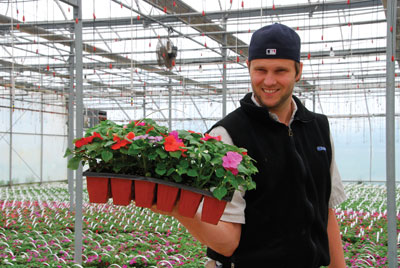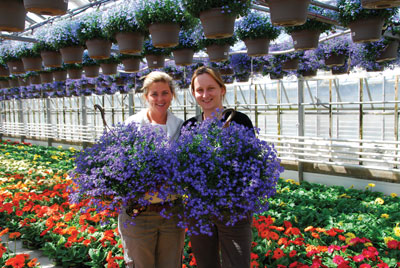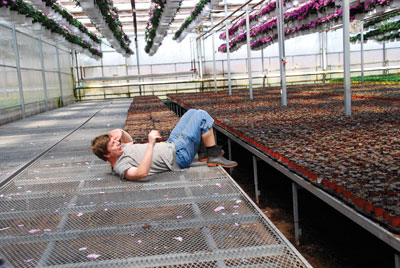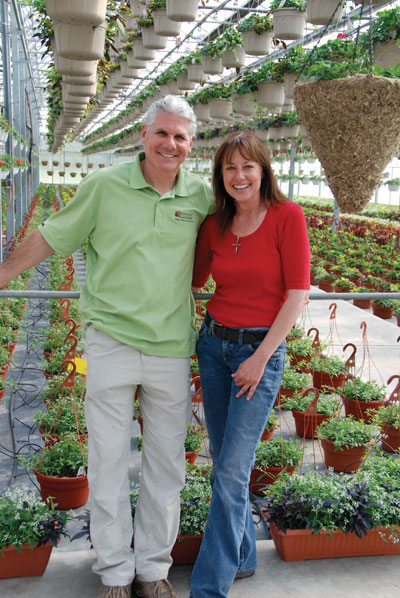
Features
Crop Culture
Inputs
Growing in the Green: Recipes for success
December 29, 2010 By Melhem Sawaya
How many of you believe in leprechauns, the tooth fairy and Santa Claus? Then let me ask, how many of you believe in New Year’s resolutions?
How many of you believe in leprechauns, the tooth fairy and Santa
Claus? Then let me ask, how many of you believe in New Year’s
resolutions?

|
| Always maintain your passion for quality. (PHOTOS COURTESY MELHEM SAWAYA) Advertisement
|
About half the number of New Year’s resolutions don’t last beyond Jan.
10 and, by Jan. 30, another 45 per cent have gone by the wayside. We
then fall back into our busy lives and into comfortable old habits.
Perhaps only five per cent of the resolutions are adopted as a way of
life rather than an event.
 |
|
| Sales are much better when the quality is consistent. |
|
 |
|
| After a busy day, take time to relax. |
|
 |
|
| Take time to laugh each day at work. |
|
 |
|
| Family time is so important. |
Smart planning means looking into the future to figure out what is needed to make our health, job and relationships better.
New Year’s resolutions are reactionary actions to a state we don’t
like. These actions have been building up for months and even years,
thus resulting in wishful thinking that we are going to reverse these
actions in a matter of days, and that’s impossible. That is why New
Year’s resolutions fail.
By no means am I implying that New Year’s resolutions are not a good
idea. Definitely, they are positives, but our expectations are not
realistic. We put ourselves under the pressure of deadlines and goals
that are unrealistic and thus we drop our resolutions and go back to
our old ways.
Growers make New Year’s resolutions at the end of June after the spring
rush and coping with their many stresses. If things run smoother,
unnecessary costs can be avoided.
a
Here is a checklist that might help in reviewing your operational
procedures and goals. I find it is much easier if I set short-term and
long-term goals.
SHORT-TERM GOALS (TARGETS)
These are the everyday functions of the greenhouse for the next year
and, by reviewing them yearly and ahead of time, it becomes much easier
to manage the list and achieve goals on your long-term list.
Facility: There are many things you can improve on where the payback
can be seen within one year, and is a benefit every year following.
Some of the projects can be done in-house during the off-season. This
avoids paying someone to do these improvements for you. Better to spend
your extra time improving the facilities than growing an extra crop you
don’t know if you can sell.
Sales Projection: I am sure by now you only grow what is sold or at
least spoken for, and not what fits into the greenhouse. Even worse is
deciding that you want to grow an extra 10 per cent not knowing if it
fits into the greenhouse, or if there are sales for it, or what impact
it would have on the profit margin rather than the dollar sale.
Costing: It is very nice to get orders that total $50,000 to $100,000,
but if the margin for profit is not there or is minimal, then the
millions of dollars in sales is an exercise in futility.
DON’T GO CHASING DOLLARS UNLESS THE MARGINS ARE THERE
We should never be tempted with dollar sales unless there is a margin
for profit. If you don’t calculate the cost of your product, then no
intelligent decisions can be made and the year-end statement could be
very disappointing. Don’t forget to consider that you could also be
missing out on increasing your profit margin.
Production: This is the process that links the sales projection and the
feasibility of achieving a premium product at the selling date at a
profitable margin. This definitely cannot be done as we go – planning
is a must! Most of the planning process is simplified by using a
spreadsheet you can print and sort for different factors.
You also need something with which you can fill your crop cookbook. (Send me an e-mail if you’d like a crop cookbook
template to use).This will help you calculate all the ingredients
needed to grow your crops. It will also help determine if your growing
area is large enough to accommodate your production without having to
move your crops more than once or, ideally, never.
It takes into account factors such as growing crops in total darkness
due to dense hanging baskets creating a canopy. What you gain in
growing on top you lose with inferior quality on the lower plants, or
in not making the sales date. Do you ever wonder why your 4" New Guinea
are not flowering on time? Well, if the plants look healthy and do not
flower, look what is above them. Lack of solar energy will delay many
cultivars.
THE RISKS OF OVERPRODUCTION
Any time there is overproduction scheduled for a limited growing area,
the margin of profit is less, quality suffers, blood pressures rise,
and it is a sure-fire recipe to lose buyers. Remember, if it is hard to
get sales for quality products, there are definitely no sales for
inferior products.
Organization: We can do all the planning we want, but if we don’t
follow through on time, then it is a waste of effort. If the plants are
not ordered on time, we might not be able to get the varieties we
require. This goes for the planting media, containers, tags, chemicals,
and most importantly, the required number of employees to get the job
done on time. Follow the cookbook for growing and adjusting according
to crop advancement, but make sure the adjustment is recorded so next
season you will minimize the adjustment.
Communication: The smallest greenhouse operation needs more than one
person to operate it and most operations are dealing with from 20 to
200 employees. Many operations are running with five to 10 per cent of
the labour they need for the spring, so planning and trying to execute
every step on time will fall apart if there is no organizational
communication in place.
HAVING FUN WITH WORK
The better your labour is organized, the more efficient the employees
will be … and it will also promote a pleasant work environment.
Building Relations: I worked in an operation where employment was 50 to
60 during slow times and jumped to 250 to 300 when we were busy, so
time for building relations was very short. However, it is amazing how
fast healthy relations are built when the environment is favourable and
top management provides every catalyst to help. I now visit many
greenhouse operations and they vary in size from 20,000 square feet to
40 acres, I realized very quickly that size is not a factor in building
a pleasant environment.
The main factor that sets the tone in the operation is the general
manager (president). He or she has 85 per cent of the influence to make
it a place where employees either love to work or they are there only
because they can’t find another job at the moment. The managers that
create a pleasant environment communicate with the staff and listen to
their constructive comments.
A greenhouse where the manager is not comfortable communicating – a
polite way of saying they don’t know what is going on – is where the
manager only manages with threats and whose only comments are to
complain about things that went wrong. Here, employees work with the
attitude of covering their back whether it’s the right decision or not.
Everyone is stressed out and there is no room for improvement.
LEAVE PERSONAL PROBLEMS AT HOME
Building constructive relations is very important in every aspect of
life and not just at work. They are important in immediate family
relationship and extended ones. The cliché, “leave your personal
business at home,” is wishful thinking and must have been written by a
person who doesn’t have immediate family and does not care about his or
her extended family. It is very important to build relations in both
the immediate family and extended family – especially when the
greenhouse operations are 90 per cent run by family members.
Long-term Planning: This takes input from everyone. Most of the time,
long-term planning without the input of the people doing the actual
work is unrealistic. By involving all employees and managers, you have
a better chance of everyone being on board.
If a second generation is involved or is to become involved, their
opinion must to be taken into consideration. If their heart, passion
and willingness are not in the business, they should look for something
else to do. Sooner or later the business will become so painful to them
that, before you know it, the whole company is on a downhill slide.
Whether there is a second generation in the picture or not, the right
people have to be in place before any expansion. With expansion, many
details start falling through the cracks unless there is a person or
persons in place to cover the different and new tasks that are
generated by the expansion.
Enlarge the customer base before expanding your facilities. Rent a
greenhouse to accommodate the new business, and if this expansion is
permanent, then building new facilities is justified.
WILL THE BIG GET BIGGER?
Do you know your customers well enough that you can plan accordingly?
Do you know what their plans are? Many of the large chains have plans
to minimize the number of their vendors. Are you are one of vendors the
customer is keeping or are you the one that is going to be dropped? By
my estimation, only five per cent of growers will be supplying 90 per
cent of the volume to chains in less than five years. Where do you
fit? Are you one of the five per cent or are you going to be one of the
95 per cent that are trying to supply the remaining 10 per cent of the
market?
Healthy customer relations are key to a healthy business. In one of my
next articles, I will share some ideas about what works and what
doesn’t work.
Personal Planning: And, last but not least, taking action to do more in
planning your personal life is what truly matters, because without
success here, you can’t concentrate on doing any of the previous points
we talked about.
In addition to personal relationships, there are few things that we
don’t like to think of, namely wills, retirement and eternity. I know
many of you are much younger than I am but these all matter. The right
time to deal with them is now. Taking care of these things will allow
you to live life more fully. It will make you more appreciative and
thankful rather than complaining about the things that don’t go your
way. In the total picture, these are really just inconveniences rather
than frustrations and many times the inconveniences can lead to
opportunities.
I know it is after Christmas and New Year, but the year is still ahead
of us. I hope you had a very blessed Christmas and wish you a
successful 2011.
Melhem Sawaya of Focus Greenhouse Management is a consultant and research coordinator to the horticultural industry. Comments on this or any other article are always welcome at mel@focusgreenhousemanagement.com, or by visiting www.focusgreenhousemanagement.com or www.sawayagardentrials.ca.
Print this page